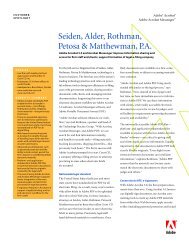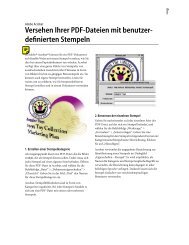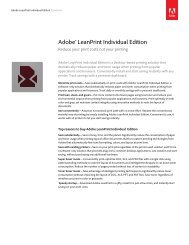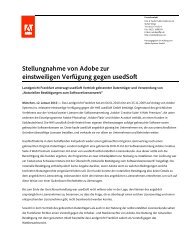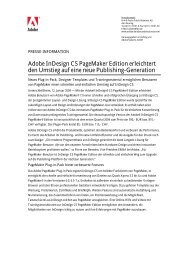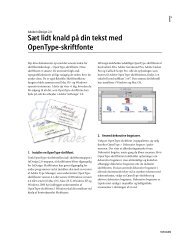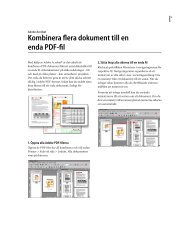Marketing's New Key Metric: Engagement (PDF,444K) - Adobe
Marketing's New Key Metric: Engagement (PDF,444K) - Adobe
Marketing's New Key Metric: Engagement (PDF,444K) - Adobe
You also want an ePaper? Increase the reach of your titles
YUMPU automatically turns print PDFs into web optimized ePapers that Google loves.
August 8, 2007<br />
Marketing’s <strong>New</strong> <strong>Key</strong> <strong>Metric</strong>:<br />
<strong>Engagement</strong><br />
by Brian Haven<br />
for Marketing Leadership Professionals<br />
Making Leaders Successful Every Day
For Marketing Leadership Professionals<br />
August 8, 2007<br />
Marketing’s <strong>New</strong> <strong>Key</strong> <strong>Metric</strong>: <strong>Engagement</strong><br />
Marketers Must Measure Involvement, Interaction, Intimacy, And Influence<br />
by Brian Haven<br />
with Josh Bernoff and Sarah Glass<br />
EXECUTIVE SUMMARY<br />
The marketing funnel is a broken metaphor that overlooks the complexity social media introduces<br />
into the buying process. As consumers’ trust in traditional media diminishes, marketers need a<br />
new approach. We propose a new metric, engagement, that includes four components: involvement,<br />
interaction, intimacy, and influence. Each of these is built from data collected from online and offline<br />
data sources. Using engagement, you get a more holistic appreciation of your customers’ actions,<br />
recognizing that value comes not just from transactions but also from actions people take to influence<br />
others. Once engagement takes hold of marketing, marketing messages will become conversations, and<br />
dollars will shift from media buying to customer understanding.<br />
TABLE OF CONTENTS<br />
2 Does The Marketing Funnel Need An<br />
Upgrade?<br />
4 <strong>Engagement</strong>: A <strong>New</strong> Perspective On<br />
Marketing<br />
The Elements Of <strong>Engagement</strong><br />
Making Sense Of <strong>Engagement</strong><br />
Putting It All Together<br />
12 <strong>Engagement</strong> Enhances Customer Insight<br />
WHAT IT MEANS<br />
13<br />
<strong>Engagement</strong> Redirects The Marketing<br />
Trajectory<br />
NOTES & RESOURCES<br />
Forrester interviewed 20 vendor and user<br />
companies, including: Avenue A | Razorfish,<br />
Bazaarvoice, Biz360, BrandIntel, BzzAgent,<br />
TNS Media Intelligence/Cymfony, Digitas, The<br />
Drilling Down Project, DuPont, LeapFrog, Loyalty<br />
Builders, MotiveQuest, Nike, Organic, Procter<br />
& Gamble, Publicis & Hal Riney, Reed Business,<br />
UGENmedia, Umbria, and Visible Technologies.<br />
Related Research Documents<br />
“The Enterprise Marketing Software Landscape”<br />
May 7, 2007<br />
“The Forrester Wave: Brand Monitoring,<br />
Q3 2006”<br />
September 13, 2006<br />
“Five Tips For Web Analytics Success”<br />
June 2, 2006<br />
© 2007, Forrester Research, Inc. All rights reserved. Forrester, Forrester Wave, RoleView, Technographics, and Total Economic Impact are<br />
trademarks of Forrester Research, Inc. All other trademarks are the property of their respective companies. Forrester clients may make one<br />
attributed copy or slide of each figure contained herein. Additional reproduction is strictly prohibited. For additional reproduction rights and<br />
usage information, go to www.forrester.com. Information is based on best available resources. Opinions reflect judgment at the time and are<br />
subject to change. To purchase reprints of this document, please email resourcecenter@forrester.com.
2<br />
Marketing’s <strong>New</strong> <strong>Key</strong> <strong>Metric</strong>: <strong>Engagement</strong><br />
For Marketing Leadership Professionals<br />
DOES THE MARKETING FUNNEL NEED AN UPGRADE?<br />
Traditionally, marketers modeled consumers’ decisions as they progressed from awareness through<br />
consideration, preference, action, and loyalty — through what is called the marketing funnel (see<br />
Figure 1-1). The marketer’s job was to move people from the large end down to the small end. But<br />
now it’s time for a rethink, as the funnel has outlived its usefulness as a metaphor. Face it: Marketers<br />
no longer dictate the path people take, nor do they lead the dialogue. We must rethink the<br />
marketing funnel because:<br />
· Complexity reigns in the middle of the funnel. Awareness is still important; you need to<br />
know that a product or service exists in order to buy it. And the marketer’s endpoint is still a<br />
transaction. But, in between, other factors such as recommendations from friends or family,<br />
product reviews, and competitive alternatives described by peers influence individuals. The<br />
funnel’s consideration, preference, and action stages ignore these forces that marketers don’t<br />
control. Rather than a clean linear path, the real process looks more like a complex network<br />
of detours, back alleys, alternate entry and exit points, external influences, and alternative<br />
resources (see Figure 1-2).<br />
· The most valuable customer isn’t necessarily someone who buys a lot. In this socially charged<br />
era in which peers influence each other as much as companies do, good customers can’t be<br />
identified solely by their purchases. 1 Companies also need to track individuals who influence<br />
others to buy. For example, a customer who buys very little from you but always rates and<br />
reviews what she buys can be just as valuable as someone who buys a lot — her reviews might<br />
influence 100 other people to buy your product. Tracking only transactions and loyalty at the<br />
end of the funnel misses this significant element of influence.<br />
· Traditional media channels are weakening. Marketers continue to use mainstream media<br />
messages to move consumers into a consideration frame of mind. But passive consumption<br />
of media is waning. Individuals dismiss or ignore marketing messages in lieu of information<br />
available from an ever-increasing number of resources, such as product review sites, message<br />
boards, and online video. 2<br />
· Consumers force brand transparency. Marketing and public relations teams used to have the<br />
influence to spin a message in their favor when something went wrong. But in these days of<br />
snoring cable technicians caught sleeping on a customer’s couch, captured on video, and posted<br />
on YouTube or blogs blasting CompUSA for selling an empty box instead of a camera, spin is<br />
out of control. 3 Online social tools, coupled with increasing social behavior online, make it easy<br />
for the truth to come out. When companies try to spin the message now, they get caught in the<br />
act, only making the problem worse.<br />
August 8, 2007<br />
© 2007, Forrester Research, Inc. Reproduction Prohibited
Figure 1 The Traditional Marketing Funnel Fails To Model Complex Buying Paths<br />
1-1<br />
42124<br />
The traditional marketing funnel<br />
Marketing’s <strong>New</strong> <strong>Key</strong> <strong>Metric</strong>: <strong>Engagement</strong><br />
For Marketing Leadership Professionals<br />
Eyeballs Awareness Consideration Preference Action Loyalty Buyers<br />
1-2<br />
Eyeballs<br />
Complexity lies at the center of the marketing funnel<br />
Peer<br />
reviews<br />
Recommendations<br />
from friends<br />
Competitive<br />
alternatives<br />
User-generated<br />
content<br />
Buyers<br />
Contributors<br />
Source: Forrester Research, Inc.<br />
© 2007, Forrester Research, Inc. Reproduction Prohibited August 8, 2007<br />
3
4<br />
Marketing’s <strong>New</strong> <strong>Key</strong> <strong>Metric</strong>: <strong>Engagement</strong><br />
For Marketing Leadership Professionals<br />
· Marketing complexity means that traditional metrics fail to capture the whole story. Online<br />
metrics like unique visitors to a Web site, number of pages viewed, and time spent per page<br />
mimic offline media metrics of reach and frequency. But these measurements don’t indicate the<br />
engagement of an individual; they fail to capture the sentiment, opinion, and affinity a person<br />
has toward a brand as manifested in ratings, reviews, comments in blogs or discussion forums,<br />
or likelihood to recommend to a friend.<br />
ENGAGEMENT: A NEW PERSPECTIVE ON MARKETING<br />
If the funnel no longer accurately reflects what marketers can influence, why do they still cling to it?<br />
Because they can measure it, which is reassuring, even if it no longer accurately reflects the real buying<br />
process. And, of course, there are no useful alternatives. We believe that marketers need a new<br />
approach to understanding customers and prospects. This new type of measurement — engagement —<br />
encompasses the quantitative metrics of site visits and transactions, the qualitative metrics of brand<br />
awareness and loyalty, and the fuzzy areas in the middle best characterized by social media. Our<br />
definition of engagement includes four components (see Figure 2): 4<br />
<strong>Engagement</strong> is the level of involvement, interaction, intimacy, and influence an individual has with<br />
a brand over time.<br />
Figure 2 The Four Components Of <strong>Engagement</strong><br />
42124<br />
August 8, 2007<br />
INVOLVEMENT INTERACTION INTIMACY INFLUENCE<br />
What To Track<br />
• Site visits<br />
• Time spent<br />
• Pages viewed<br />
• Search keywords<br />
• Navigation paths<br />
• Site logins<br />
How To Track<br />
• Contributed comments<br />
to blogs<br />
• Quantity/frequency<br />
of written reviews,<br />
blog comments,<br />
forum discussions, and<br />
UGC<br />
• Sentiment tracking on<br />
third-party sites (blogs,<br />
reviews, forums, etc.)<br />
• Sentiment tracking of<br />
internal customer<br />
contributions<br />
• Opinions expressed in<br />
customer service calls<br />
• Net Promoter (NP)<br />
score<br />
• Product/service<br />
satisfaction ratings<br />
• Brand affinity<br />
• Content forwarded to<br />
friends<br />
• Posts on high-profile<br />
blogs<br />
• Web analytics • eCommerce platforms • Brand monitoring • Brand monitoring<br />
• Social media platforms • Customer service calls • Customer service calls<br />
• Surveys • Surveys<br />
Source: Forrester Research, Inc.<br />
© 2007, Forrester Research, Inc. Reproduction Prohibited
The Elements Of <strong>Engagement</strong><br />
Marketing’s <strong>New</strong> <strong>Key</strong> <strong>Metric</strong>: <strong>Engagement</strong><br />
For Marketing Leadership Professionals<br />
<strong>Engagement</strong> goes beyond reach and frequency to measure people’s real feelings about brands. It starts<br />
with their own brand relationship and continues as they extend that relationship to other customers.<br />
As a customer’s participation with a brand deepens from site use and purchases (involvement<br />
and interaction) to affinity and championing (intimacy and influence), measuring and acting<br />
on engagement becomes more critical to understanding customers’ intentions. The four parts of<br />
engagement build on each other to make a holistic picture.<br />
· Involvement. This component is the most basic measurement of engagement and reflects the<br />
measurable aspects of an individual’s relationship with a company or brand. It includes actions<br />
like visits to a site or a physical store, time spent per page, and pages viewed. While this alone<br />
isn’t sufficient, measuring these activities is critical because they are often the first point of<br />
interaction an individual has with a brand and are the foundation for making the connections to<br />
other metrics. 5 For example, Reed Business tracks visitors to its Web sites, the time they spend,<br />
the articles they read by category or channel, and pages they view per week (and across other<br />
time periods). This helps Reed Business distinguish between first-time and repeat visitors, and<br />
informs the company of the depth, frequency, and level of interactions of their visits, helping it<br />
determine its content agenda. You can use Web analytics services like Omniture, Web Trends, or<br />
Visual Sciences to measure these activities. 6<br />
· Interaction. This component provides the depth that involvement alone lacks by measuring<br />
events in which individuals contribute content about a brand, request additional information,<br />
provide contact information, or purchase a product or service. Where involvement measures<br />
touches, interaction measures actions. These include click-throughs, completed transactions,<br />
blog comments, social network connections, and uploaded photos and videos. Social media<br />
contributions increasingly play a role in calculating the value of a customer and are vital to<br />
tracking emerging behaviors. For example, PETCO tracks when customers browse and sort<br />
by top-rated items and then buy a product, allowing the company to identify the effect usergenerated<br />
content (UGC) has on purchases. You can use eCommerce platforms to provide<br />
transaction data, while social media platforms like Bazaarvoice and UGENmedia track actions<br />
like ratings and reviews, photos or videos uploaded, or connections made in social networks.<br />
· Intimacy. This component goes beyond interaction to measure the affection or sentiment an<br />
individual holds for a brand. This includes her opinion, perspective, or passion for the brand<br />
as represented by the words she uses and the content she creates. Intimacy is the critical new<br />
component that sheds light on customer’s feelings about your brand (positive or negative), and,<br />
with new services, it can be tracked almost in real time, providing ample opportunity to correct<br />
a problem or seize an opportunity before it wanes. For example, Del Monte’s pet food division<br />
used Umbria’s brand monitoring services to track online conversations about how owners<br />
perceive their pets, yielding fascinating differences — for example, Gen Yers think of them as<br />
© 2007, Forrester Research, Inc. Reproduction Prohibited August 8, 2007<br />
5
6<br />
Marketing’s <strong>New</strong> <strong>Key</strong> <strong>Metric</strong>: <strong>Engagement</strong><br />
For Marketing Leadership Professionals<br />
accessories, Gen Xers think of them as family and worry about how to fit them into their busy<br />
schedule, and Boomers consider them people too. Brand monitoring firms like TNS Media<br />
Intelligence/Cymfony, MotiveQuest, Biz360, Umbria, and BrandIntel measure sentiment in<br />
online venues, including social networks, discussion forums, blogs, and video-sharing sites. 7<br />
· Influence. This component looks beyond even sentiment to determine an individual’s likelihood<br />
to encourage a fellow customer to consider or buy a brand, product, or service. Qualitatively,<br />
it includes brand awareness, loyalty, and the possibility of purchasing again. It also includes<br />
quantitative metrics like the Net Promoter (NP) score, measuring a person’s likelihood to<br />
make a recommendation to a friend. 8 Understanding your customer’s intention to return,<br />
repurchase, or recommend is critical to building a forward-looking profile of your customer.<br />
For example, BrandIntel tracked sentiment about the film Snakes On A Plane and TV series<br />
Heroes. Eighty percent of the conversation about Snakes On A Plane focused on the hype of<br />
the film and Samuel L. Jackson the actor, not his character, while Heroes conversations were all<br />
about the characters and the premise of the show. This is why Heroes is a hit and Snakes was a<br />
flop; BrandIntel’s studies show that people aren’t really engaged unless they’re talking about plot<br />
and characters rather than hype and actors. You can measure influence through opt-in surveys,<br />
mailed questionnaires, or customer service calls and phone surveys.<br />
Making Sense Of <strong>Engagement</strong><br />
With a new set of components — involvement, interaction, intimacy, and influence — companies<br />
can integrate data from many sources to build the engagement profile, an aggregate description of<br />
the types and levels of engagement your customers exhibit. But with all this new data, what metrics<br />
matter, and how can you combine them? To understand how engagement affects customer value,<br />
consider these three customer scenarios that reflect different customers and how they approach one<br />
brand, an online retailer:<br />
· Charlie: passive participant. Charlie’s just not that into you. You see him on your site as an<br />
occasional visitor who does not recommend the brand and reads the company blog about<br />
gadgets but does not comment. Still, his behaviors on the site liken him to people who tend to<br />
have a favorable sentiment about the products they’re researching (see Figure 3). Since Charlie<br />
isn’t a registered user, you’ll need to track his actions on the site (pages viewed, time spent, etc.)<br />
and measure the sentiment of the occasional anonymous content he contributes (comments,<br />
discussions, etc.) as well as the sentiment on the sites and pages that refer him, tracked through<br />
browser cookies. In your analysis of engagement of visitors like Charlie, you would match their<br />
characteristics to similar users who are registered and, from that, extrapolate their loyalty and<br />
likeliness to recommend.<br />
· Steven: semiactive participant. Steven is ready to be turned on to your brand. He visits the<br />
site in bursts surrounding product purchases, has become loyal, and writes highly influential<br />
reviews of the sports equipment products he buys, even though he feels that the product<br />
August 8, 2007<br />
© 2007, Forrester Research, Inc. Reproduction Prohibited
Marketing’s <strong>New</strong> <strong>Key</strong> <strong>Metric</strong>: <strong>Engagement</strong><br />
For Marketing Leadership Professionals<br />
research tools and information are lacking (see Figure 4). For users like Steven, you should<br />
track activities surrounding purchases (before and after) and the time between a transaction<br />
and his review of the product. Measure the sentiment of product reviews, the actions taken after<br />
reading unfavorable content, and the influence his reviews have on other customers’ purchasing<br />
behaviors. You need to ascertain what motivates him to contribute content and try to encourage<br />
more of that behavior.<br />
· Sarah: brand zealot. Sarah could turn out to be one of your most valuable customers. She is an<br />
avid fan of the site’s pet accessories, is a highly active visitor who recommends the site to every<br />
pet owner she knows, and actively contributes content to the site’s online community, even<br />
though she sometimes posts negative comments about products after making customer service<br />
calls (see Figure 5). For zealots like Sarah, it’s important to track the quantity and frequency of<br />
reviews, profile updates, blog posts, forum discussions, and other content contributions. You<br />
should also measure the sentiment of her contributions and use surveys to keep a pulse on her<br />
affinity for the brand and intent to continue to participate. For some brands, it would make<br />
sense to start a brand ambassador program to draw users like Sarah closer to the company and<br />
energize their word-of-mouth.<br />
© 2007, Forrester Research, Inc. Reproduction Prohibited August 8, 2007<br />
7
8<br />
Marketing’s <strong>New</strong> <strong>Key</strong> <strong>Metric</strong>: <strong>Engagement</strong><br />
For Marketing Leadership Professionals<br />
Figure 3 Passive Participant<br />
Involvement Interaction Intimacy<br />
Influence<br />
Activities<br />
• Visits the site one to two<br />
times per month<br />
• Spends about 10 to 15<br />
minutes browsing<br />
• Primarily uses search to<br />
find products<br />
• Browses the tech<br />
gadgets category<br />
• Seems to purchace<br />
at the physical<br />
retail locations<br />
•10% of the time, Charlie<br />
is referred from a<br />
third-party review site<br />
Level of intensity from low to high<br />
42124<br />
August 8, 2007<br />
PROFILE—CHARLIE<br />
• Passive participant<br />
• Reads and views others’ contribution<br />
• Only participates on rare occasions<br />
• Not registered on the site<br />
• Reads company blogs<br />
about products<br />
• Commented on blog<br />
posts three times in the<br />
past six months<br />
• Reads customer reviews<br />
• Text analysis shows that<br />
the few comments<br />
Charlie makes tend to<br />
show favorable<br />
sentiment<br />
• Text analysis of the<br />
reviews Charlie reads<br />
includes both favorable<br />
and unfavorable<br />
reviews of the product<br />
• Text analysis of the<br />
views on third-party<br />
review sites, particularly<br />
the site that refers<br />
Charlie on occasion,<br />
tend to be slightly less<br />
favorable<br />
• Basic demographics of<br />
gadget lovers show that<br />
Charlie is most likely<br />
male, 18 to 35, with<br />
moderate to high<br />
income (he’s<br />
actually 28 with low to<br />
moderate income)<br />
• People in this segment<br />
who are linked to<br />
registration data and<br />
browse the same<br />
categories have low<br />
NP scores and rank the<br />
products and online<br />
services as “satisfactory”<br />
Lo Hi Lo Hi Lo Hi Lo Hi<br />
Source: Forrester Research, Inc.<br />
© 2007, Forrester Research, Inc. Reproduction Prohibited
Figure 4 Semiactive Participant<br />
Marketing’s <strong>New</strong> <strong>Key</strong> <strong>Metric</strong>: <strong>Engagement</strong><br />
For Marketing Leadership Professionals<br />
Involvement Interaction Intimacy<br />
Influence<br />
Activities<br />
• Just made a recent<br />
purchase after 12<br />
months of inactivity<br />
• Typically visits the site<br />
three to four times<br />
per month<br />
• Browses forums and<br />
company blogs just<br />
before and after buying<br />
• On average, spends 25<br />
minutes on the site<br />
browsing<br />
Level of intensity from low to high<br />
42124<br />
PROFILE—STEVEN<br />
• Semiactive participant<br />
• Fan of the brand<br />
• Contributes in large bursts,<br />
with big gaps in between<br />
• Wrote a review of a<br />
recently purchased<br />
product; 32% of the<br />
people who read his<br />
review (53) purchased<br />
the product<br />
• Commented on six posts<br />
from the company blog<br />
about specific products<br />
• Engaged in a weeklong<br />
discussion in a forum on<br />
the company’s site on a<br />
recently released<br />
product<br />
• Read an unfavorable<br />
comment about a<br />
product by another<br />
member and requested<br />
to return the product 20<br />
minutes later<br />
• Most comments about<br />
the company are<br />
favorable<br />
• An identical username<br />
on a third-party site<br />
shows that he finds the<br />
research tools lacking<br />
some key features<br />
• Steven commonly<br />
responds to questions<br />
posed by other<br />
members in the<br />
company’s forums<br />
• NP score of 8.7 for the<br />
company’s services<br />
• Recently set up his<br />
profile and forwarded<br />
links of the products he<br />
likes to his friends<br />
• Survey responses from<br />
multiple touchpoints<br />
indicate that Steven is<br />
highly loyal to the brand<br />
Lo Hi Lo Hi Lo Hi Lo Hi<br />
Source: Forrester Research, Inc.<br />
© 2007, Forrester Research, Inc. Reproduction Prohibited August 8, 2007<br />
9
10<br />
Marketing’s <strong>New</strong> <strong>Key</strong> <strong>Metric</strong>: <strong>Engagement</strong><br />
For Marketing Leadership Professionals<br />
Figure 5 Brand Zealot<br />
Involvement Interaction Intimacy<br />
Influence<br />
Activities<br />
• Visits the site three to<br />
five times per week<br />
• Spends 7 hours on the<br />
site weekly<br />
• Views top-rated<br />
products and new<br />
customer reviews<br />
regularly<br />
• Highly passionate about<br />
products for her pets<br />
Level of intensity from low to high<br />
42124<br />
August 8, 2007<br />
PROFILE—SARAH<br />
• Active participant<br />
• Brand zealot<br />
• Contributes content<br />
• Connects with other customers<br />
• Updates her on-site<br />
social network profile<br />
weekly<br />
• Rates 90% of all<br />
non-pet-food purchases<br />
• Reviews half of all<br />
non-pet-food purchases<br />
• Uploads photos and<br />
videos of her pets<br />
• Contributes topics to<br />
company discussion<br />
forums<br />
• Uses on-site blog tool to<br />
write about caring for<br />
pets<br />
• Answers forum<br />
questions<br />
• Reviews are mostly<br />
positive, but some are<br />
negative when the<br />
product falls short of<br />
expectations<br />
• Negative comments<br />
about products<br />
correlate with customer<br />
service calls about the<br />
product<br />
• A matching username<br />
on a popular third-party<br />
site about pets matches<br />
commentary posted on<br />
the company’s site<br />
• NP score for the brand is 9<br />
• Advocates products on<br />
her blog<br />
• Has high satisfaction<br />
rates with the brand and<br />
products<br />
• Indication that she<br />
recommends the brand<br />
to friends and family<br />
Lo Hi Lo Hi Lo Hi Lo Hi<br />
Source: Forrester Research, Inc.<br />
© 2007, Forrester Research, Inc. Reproduction Prohibited
Putting It All Together<br />
Marketing’s <strong>New</strong> <strong>Key</strong> <strong>Metric</strong>: <strong>Engagement</strong><br />
For Marketing Leadership Professionals<br />
Now that you know what information to collect, can we provide you with a formula to measure<br />
engagement? Well, no, because it’s different for each company. But you can start by identifying the<br />
key metrics that are useful to you and use them to choose and work with vendors of measurement<br />
technology. 9 The engagement profiles you track will be different depending on your marketing<br />
strategy. Here are four recipes for measuring engagement, matched to company objectives:<br />
· Your objective is to create awareness. Start as you always have, tracking existing online ads,<br />
promotions, and TV commercials. To this, add tracking content contributed by brand advocates,<br />
such as product reviews or comments in discussion forums. Measure the sentiment of that<br />
UGC, including venues you don’t control such as third-party product review sites. Additionally,<br />
track influence through customers’ intent to recommend the product to a friend by conducting<br />
a survey or witnessing actions on peer review sites like Epinions and TripAdvisor. 10 A good<br />
example: A large national financial institution used brand monitoring service Biz360 to identify<br />
key message pickup from its Superbowl ad in both traditional and interactive channels, and<br />
used that buzz measurement to evaluate the expenditure.<br />
· Your objective is to drive transactions. Track involvement to identify how people use your<br />
site (page views, navigation paths, etc.) and merge that information with the effect UGC has on<br />
others’ purchases. This way you can discover the content and actions that increase a customer’s<br />
likelihood to buy. For example, CompUSA uses Bazaarvoice’s services to provide product<br />
ratings and reviews, then tracks the effect reviews have on the buying behavior of readers.<br />
They’ve found that customers acquired via review-related searches convert at a 60% higher rate<br />
than the average customer and spend 50% more per order.<br />
· Your objective is to build brand preference. Track involvement on your own site as well as<br />
referrals from other sites to identify the content people use to make decisions. Understanding<br />
how intimate customers are with your brand and what increases intimacy will establish what<br />
it takes to convince a person to choose you over a competitor. For example, a large auto<br />
manufacturer launched a new SUV, but sentiment in discussion forums (measured using brand<br />
monitoring services) indicated that the off-road capabilities of the vehicle were not believable.<br />
Then, using imagery of the SUV performing in off-road conditions, the company was able to<br />
track a change in perception, which resulted in outselling its competitors that quarter.<br />
· Your objective is to increase loyalty. Track recurring purchases, positive commentary, and<br />
intent to recommend. Analyze the characteristics and behaviors of known loyalists to determine<br />
what you should do to motivate potential loyalists to make the leap. Monitor sentiment about<br />
products in forums and in blog comments to track those actions that commonly encourage or<br />
discourage repeat purchase and respond accordingly through incentives, product modifications,<br />
or services enhancements. For example, in 2006, Mini Cooper decided to boost its community<br />
© 2007, Forrester Research, Inc. Reproduction Prohibited August 8, 2007<br />
11
12<br />
Marketing’s <strong>New</strong> <strong>Key</strong> <strong>Metric</strong>: <strong>Engagement</strong><br />
For Marketing Leadership Professionals<br />
efforts in a year with no new product announcements to strengthen loyalty and avoid being<br />
seen as a fad. Working with MotiveQuest, it used brand monitoring services and confirmed<br />
that the emotion expressed by owners in the Mini community set it apart from other vehicles.<br />
In addition, Mini Cooper was able to monitor the results of the brand’s community efforts and<br />
evolve future communications.<br />
ENGAGEMENT ENHANCES CUSTOMER INSIGHT<br />
Measuring engagement is a new concept, and no measurement vendors provide unified services<br />
to help tie it all together — yet. To get started, you’ll need to take the first steps alone. But starting<br />
small and remaining focused on a few objectives at a time (such as connecting UGC to increased<br />
purchases or linking sentiment to loyalty) allows you to identify the metrics that matter to you most.<br />
Integrate your customer perspective across channels and campaigns by using a variety of online and<br />
offline metrics, so you can calculate the value of new channels and identify efficient strategies for<br />
them. 11 And consider the payoff of your hard work. You’ll be able to:<br />
· Measure and learn from things you currently ignore. Qualitative metrics like feelings, affinity,<br />
and sentiment are difficult to track. And when you can collect the information, it has historically<br />
been complicated or impossible to use with other data. But social media makes it easier for<br />
customers to offer up their opinion, and, as a result, all that data is sitting out there waiting to be<br />
mined. Companies should track these metrics on a regular basis with brand monitoring services,<br />
partly to get insights that no survey would ever detect, since they come right from the minds<br />
of the customers. For example, a kitchen hardware manufacturer should track commentary in<br />
discussion forums about home renovation to get ideas about product shortcomings, identify<br />
new or improved products, and track impact on actual sales.<br />
· Identify customers who influence others to buy. A person who contributes content, such as<br />
a product review or a video of the product in use, may be far more valuable than the average<br />
purchaser. 12 As a result, your idea of who you consider a good customer should become<br />
more robust, and you should make tactical offers with finer control to drive the behavior of<br />
these customers. For example, a sporting goods retailer should identify customers who make<br />
significant product reviews that influence others’ purchases, then initiate programs to encourage<br />
those customers to contribute more content.<br />
· Encourage behavior across multiple touchpoints — online and offline. The engagement<br />
profile crosses channels. Once you establish engagement profiles based on online data, the<br />
next step is to tie in data from offline sources, such as in-store transactions, phone or catalog<br />
orders, and customer service calls. For example, a quick service restaurant should determine<br />
if customers that are heavy users of its in-store loyalty program are more likely to provide<br />
favorable sentiment in online discussion forums or possess an increased likelihood to<br />
recommend the food to a friend.<br />
August 8, 2007<br />
© 2007, Forrester Research, Inc. Reproduction Prohibited
W H A T I T M E A N S<br />
ENGAGEMENT REDIRECTS THE MARKETING TRAJECTORY<br />
Marketing’s <strong>New</strong> <strong>Key</strong> <strong>Metric</strong>: <strong>Engagement</strong><br />
For Marketing Leadership Professionals<br />
As they understand and leverage customer engagement, firms will begin to collaborate with loyal,<br />
passionate users on brand messages. But the further implications are broad and sweeping.<br />
· Rather than just targeting new customers, firms will increasingly market to their alumni.<br />
As engagement exposes the value of UGC, brand graduates will become the new target. Even<br />
customers who no longer have a need for your products or services still have something<br />
to say. Marketers will target customers who have exited the final life-stage of your product,<br />
enticing them to provide parting wisdom for existing customers. For example, imagine if<br />
Pampers awarded points redeemable at Gap Kids for customers that continue to participate in<br />
discussions about baby care, even after their own child no longer needs Pampers’ products.<br />
· <strong>Metric</strong>s will focus on the acquisition of evangelists rather than purchasers. Marketers<br />
currently measure the performance of interactive marketing tactics with metrics like cost<br />
per thousand views (CPM), cost per click (CPC), or cost per acquisition (CPA). As marketers<br />
establish the value of a contribution in relation to a purchase, a new metric will emerge:<br />
the cost per acquired advocate (CPAA). Nike may determine that the cost to recruit runner<br />
hobbyists who are vocal about Nike’s products is more effective than marketing solely to<br />
ordinary shoe buyers, because the advocates influence other runners to buy.<br />
· People will hold brands to higher quality standards. Marketers will begin to allow<br />
evangelists and contributors to collaborate on the brand message. When this transition<br />
happens, customers will demand better quality, refusing to jeopardize their credibility in<br />
the community over poor-quality products. This customer requirement will force companies<br />
to increase spending in R&D and add a new group within marketing: the Customer<br />
Understanding Group. For example, Verizon FiOS might learn that customers demand<br />
improved service performance before they’ll volunteer to advocate the brand. As a result,<br />
Verizon could assemble a team of marketers, product development specialists, and market<br />
researchers to conduct a customer needs study and redesign its service to perform better<br />
and meet new customer desires.<br />
· Marketing dollars will shift from outbound communication to data analysis. With the<br />
brand message partly in the hands of loyal customers, the marketing organization will<br />
realize that fewer dollars need to be spent on mass communication. Marketing spend will<br />
shift to building and nurturing brand zealots, while simultaneously reducing traditional<br />
and interactive marketing efforts. Many of these marketing dollars will shift to expenditures<br />
on data acquisition and data mining. Imagine if Procter & Gamble redirected 20% of its<br />
marketing budget in traditional media and dedicated those new dollars to interactive<br />
marketing efforts, enterprise marketing measurement, and database management services.<br />
The marketer’s fortunes as a brand company would then shift — careers would soar in data<br />
analysis and stagnate in media spending.<br />
© 2007, Forrester Research, Inc. Reproduction Prohibited August 8, 2007<br />
13
14<br />
Marketing’s <strong>New</strong> <strong>Key</strong> <strong>Metric</strong>: <strong>Engagement</strong><br />
For Marketing Leadership Professionals<br />
· Audience, not product or channel, will define the new marketer. Rather than focus<br />
on areas of expertise aligned with a channel or industry, the marketing organization will<br />
shift to a customer organization. As she focuses on influencers and consumer knowledge,<br />
the new marketer will develop a career based on her understanding of, for example,<br />
new moms, young athletes, or women reaching menopause. For example, Alison Zelen,<br />
Consumer & Market Insight manager for Axe Body Spray at Unilever, succeeded based on<br />
her intimate understanding of how young men think, gained partly from watching them in<br />
a Communispace community. 13 This is knowledge that transcends the consumer packaged<br />
goods category.<br />
· <strong>Engagement</strong> will force B2B marketers to take the social media plunge. B2B marketers’<br />
slow adoption of social technologies will be accelerated when community sites emerge<br />
discussing the merits (benefits and limitations) of their products and services. 14 B2B<br />
marketers will recognize that social media is critical to their business because all of their<br />
customers are online and one unhappy customer can cost them millions of dollars in<br />
business. Imagine this: A new enterprise product from HP, Oracle, or Microsoft fails to deliver<br />
on its promise for a prominent client. The key decision-maker at the client company is an avid<br />
blogger and posts about the poor performance of the product. A groundswell of unhappy<br />
customers develops, and three developing deals fall through as a result, costing the vendor<br />
more than $5 million in potential new business. Events like this will persuade B2B marketers<br />
in a heartbeat to measure engagement.<br />
ENDNOTES<br />
1 More than one-quarter of online consumers contribute to discussion boards or submit a rating or review of<br />
a product. See the January 25, 2007, “Leveraging User-Generated Content” report.<br />
2 Only 13% of consumers say they buy products because of their ads, and a mere 6% believe that companies<br />
generally tell the truth in ads. See the November 27, 2007, “Consumers Love To Hate Advertising” report.<br />
3 The video of the Comcast technician is located at http://www.youtube.com/watch?v=CvVp7b5gzqU. The<br />
blog post about CompUSA’s sale of an empty camera box is located at http://www.thepomoblog.com/<br />
archive/lifeslices-all-sales-final-is-not-a-license-for-theft.<br />
4 In marketing today, the term engagement has a plethora of definitions coming from many different<br />
organizations. For example, the Advertising Research Foundation (ARF) defines engagement as: “turning<br />
on a prospect to a brand idea enhanced by the surrounding context.” The Web Analytics Association sticks<br />
to today’s components of measurement (internal search terms, top pages and content requested, customer<br />
retention rate, time for a user to navigate the site, etc.) to help encourage better usability. But we’re arguing<br />
for a more comprehensive definition that addresses all of the many touchpoints an individual has with a<br />
brand. The ARF definition of engagement can be found at http://www.thearf.org/research/engagement.<br />
html. The Web Analytics Association explanation of measuring engagement is located at http://www.<br />
webanalyticsassociation.org/en/art/?102.<br />
August 8, 2007<br />
© 2007, Forrester Research, Inc. Reproduction Prohibited
Marketing’s <strong>New</strong> <strong>Key</strong> <strong>Metric</strong>: <strong>Engagement</strong><br />
For Marketing Leadership Professionals<br />
5 To get the most out of your Web analytics efforts: 1) connect customer behavior to business results; 2)<br />
present analytics data to business owners regularly; 3) assign a single owner to each metric; 4) create rapid<br />
response plans; and 5) add staff to accelerate ROI. See the June 2, 2006, “Five Tips For Web Analytics<br />
Success” report.<br />
6 Based on our analysis, four vendors rose to the top of our evaluation: WebTrends for its strengthening<br />
product line, flexible deployment, and global presence; Omniture because of its all-around solid product<br />
and training offerings; Visual Sciences for its market-leading technology; and Coremetrics for its<br />
respectable product coupled with the market’s best customer service. See the January 13, 2006, “The<br />
Forrester Wave: Web Analytics, Q1 2006” report.<br />
7 As consumers usurp control from companies, marketers are forced to listen more, shout less, and interact<br />
on a regular basis. Brand monitoring services have emerged to specifically focus on helping firms listen. See<br />
the September 13, 2006, “The Forrester Wave: Brand Monitoring, Q3 2006” report.<br />
8 Net Promoter alone isn’t enough, but alongside other insights about customers’ motivations, other metrics<br />
about customer experience touchpoints, and operational programs, Net Promoter becomes an important<br />
input into a broader measurement process. See the February 2, 2007, “Net Promoter Scores: Good, But Not<br />
Enough” report.<br />
9 Marketers need technologies that improve marketing processes and help deliver relevant and consistent<br />
customer experiences across multiple channels. Leading enterprise marketing platform (EMP) vendors<br />
aspire to be the comprehensive suite. See the May 7, 2007, “The Enterprise Marketing Software Landscape”<br />
report.<br />
10 Product reviews can be found at Epinions (http://www.epinions.com), and travel reviews can be found at<br />
TripAdvisor (http://www.tripadvisor.com/).<br />
11 As marketers make strides to become more customer-centric, their need for a single agency of record<br />
diminishes. Over time, these marketers become better at managing integrated marketing campaigns<br />
— which results in spreading budgets across different agency types, building up internal capabilities, and<br />
experimenting with risk-sharing contract structures with their agencies. See the February 23, 2007, “Help<br />
Wanted: 21st-Century Agency” report.<br />
12 <strong>New</strong> tools of Web 2.0 promise to dominate the shopping landscape in the years to come. This will launch<br />
a cycle in which more consumers become comfortable using the Internet for information created by<br />
other consumers and then begin to create content of their own. See the February 20, 2007, “Trends 2007:<br />
eCommerce And Online Retail” report.<br />
13 Communispace builds and runs online communities to provide product and marketing insight for its<br />
clients. More information is available at its Web site: http://www.communispace.com.<br />
14 B2B marketers admittedly stick to marketing tactics they say fail to work as well as they would like. See the<br />
August 2, 2006, “B2B Marketing Needs A Makeover — Now” report.<br />
© 2007, Forrester Research, Inc. Reproduction Prohibited August 8, 2007<br />
15
M a k i n g L e a d e r s S u c c e s s f u l E v e r y D a y<br />
Headquarters<br />
Forrester Research, Inc.<br />
400 Technology Square<br />
Cambridge, MA 02139 USA<br />
Tel: +1 617.613.6000<br />
Fax: +1 617.613.5000<br />
Email: forrester@forrester.com<br />
Nasdaq symbol: FORR<br />
www.forrester.com<br />
Forrester Research, Inc. (Nasdaq:<br />
FORR) is an independent<br />
technology and market research<br />
company that provides pragmatic<br />
and forward-thinking advice to<br />
global leaders in business and<br />
technology. For more than 24 years,<br />
Forrester has been making leaders<br />
successful every day through its<br />
proprietary research, consulting,<br />
events, and peer-to-peer executive<br />
programs. For more information,<br />
visit www.forrester.com.<br />
Research and Sales Offices<br />
Australia Israel<br />
Brazil<br />
Japan<br />
Canada Korea<br />
Denmark The Netherlands<br />
France<br />
Switzerland<br />
Germany United Kingdom<br />
Hong Kong<br />
India<br />
United States<br />
For a complete list of worldwide locations,<br />
visit www.forrester.com/about.<br />
For information on hard-copy or electronic reprints, please contact the Client<br />
Resource Center at +1 866.367.7378, +1 617.617.5730, or resourcecenter@forrester.com.<br />
We offer quantity discounts and special pricing for academic and nonprofit institutions.<br />
42124




